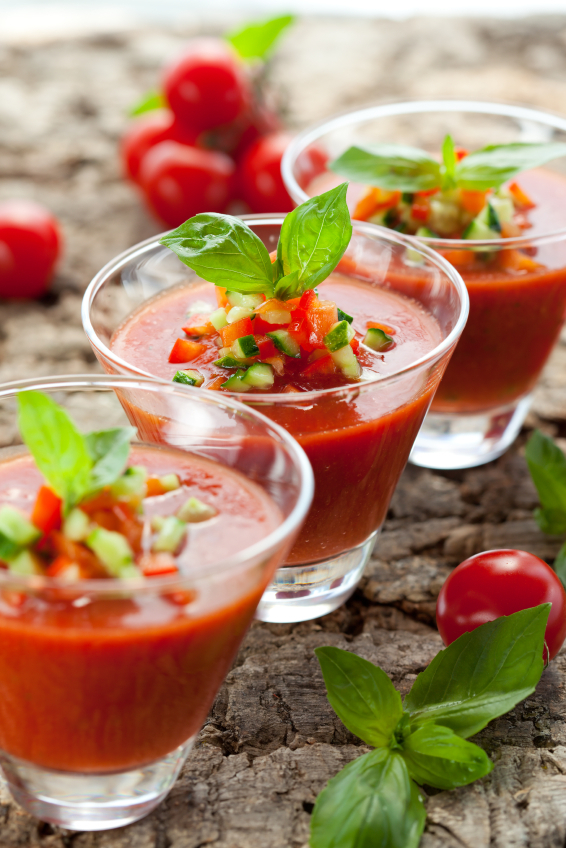A few years ago my eldest brother came out from the East Coast for an extended visit. Having grown up in the San Francisco Bay Area, there were many places he wanted to see while in town but his number one was Napa Valley. He loves good food and wine so I arranged for us to take a wine blending class and then we had lunch at one of the best restaurants in the Valley, Julia’s Kitchen.
It was one of those perfect days in Napa, a bright sunny day with a light breeze. We sat on the terrace enjoying the exceptional September weather. If you are planning a trip to San Francisco, come in September or October. It is when we have the best weather of the year. Course after exceptional course was delivered to our table, each one accompanied by a perfectly matched wine. Each was incredibly prepared and plated, but the one that is still lingering in my mind was the starter, a tiny shooter of the most perfect gazpacho I have ever had.
It was a blend of vegetables so perfectly balanced that you could taste each one even though they had been pureed into a slightly thickened soup. Served at cool room temperature, the flavors bloomed in your mouth as you sipped the luscious liquid, each taste more flavorful than the last. I could have eaten a whole bowl of it, but that two-ounce portion was so powerful that I can still taste it in my mind, all these years later.
Located in the now defunct COPIA Center, Julia’s Kitchen was named for and inspired by Julia Child. It was a delightful place with a wall of windows looking out on the vast gardens. They grew all their own produce organically and were cultivating many heirloom varieties. The brainchild of Robert Mondavi, COPIA was a museum-like facility dedicated to educating and celebrating wine and food which has unfortunately closed. I have hopes that someone will figure a way to reinvent it. I miss it.
In this country, gazpacho is most often made with a combination of fresh tomatoes, bell peppers, cilantro and stale bread. The original versions in Europe date back prior to the introduction of tomatoes in the 16th century and were made with ground almonds, cucumbers, yogurt and garlic. Probably originating with the Moors it is called “ajo blanco” and is high in protein thanks to the almonds and yogurt. Another early version is a green gazpacho which was made with spinach, lettuce and parsley along with yogurt and chicken broth. This most likely originated in Andalusia and was eaten by workers in the field, providing them with a cooling and healthy meal.

Grilling Poblano Peppers
Here is some fun trivia. Do you know why people used to think that tomatoes were poisonous? Rich people in the 1500s used plates and utensils made of pewter which was very high in lead. Acidic foods like tomatoes reacted with the pewter causing the lead to leach out which resulted in food poisoning and often death. Poor people used wooden implements and were not adversely affected. Cultivation of tomatoes in Mediterranean countries began in the 1540s but it took until the 1800s for anyone but the poor would eat them.
I love today’s unusual version because it utilizes lightly grilled vegetables, lending a complex smoky flavor to the soup. Be sure not to cook the vegetables any longer than necessary for the flavor and amount of charring you desire. You still want the fresh flavors to come through. While you are at it, grill some extra vegetables and you can use them in pasta salads, tossed with cooked rice, or used to stuff peppers, zucchini or tomatoes.
Enjoy this amazing blending of summer flavors with an artisan loaf of crusty bread to soak up every last drop!

Grilled Zucchini
Jane’s Tips and Hints:
Most of the silk on fresh corn is attached to the top 2 inches of the cob. Pull back the husks slightly at the top and pull out most of the silk. This will make cleaning the cobs much easier!
Kitchen Skill: How to Safely Cut Kernels off Corn on the Cob
There are two ways to easily and safely cut the kernels off corn on the cob, but both depend on using a very sharp knife so you don’t have to exert a lot of pressure. The first, and the way I cut my corn, is to break each cooked ear of corn in half. This way you have a stable flat surface to set on the cutting board. Corncobs are surprisingly easy to break in half, especially once cooked. If the kernels are bouncing around your kitchen, you can always cut the corn on a clean kitchen towel which will capture most of the kernels.
The second method is to utilize either an angel food cake pan or bundt pan. Set the cob on the center post of the pan, slender end up. Very carefully slice the kernels off the cob, letting them fall into the cake pan.


- 4 large garlic cloves, unpeeled
- 2 large red bell peppers, cored and quartered
- 2 large yellow bell peppers, cored and quartered
- 1 small jalapeno pepper, stemmed, halved and seeds removed
- 1 large tomato
- 2 medium zucchini, sliced lengthwise 1/2 inch thick
- 1 large white onion, cut into 1/2-inch slabs
- 3 ears of corn, husked
- 2 tbsp vegetable oil
- 1 English cucumber, peeled; half of it seeded and cut into chunks, the rest sliced thinly or minced
- Kosher salt and freshly ground pepper
- 1-1/2 tsp ground cumin
- 1 cup tomato juice
- 1/2 cup fresh orange juice
- 3 tbsp fresh lemon juice
- 2 tbsp red wine vinegar
- 1/4 cup chopped cilantro
- Light a grill. Thread the garlic cloves onto a skewer. Lightly brush the garlic, bell peppers, jalapeno, tomato, zucchini, onion and corn with the vegetable oil and season with salt and pepper. Grill the vegetables over moderately high heat, turning frequently, until lightly charred and crisp-tender, about 10 minutes. Transfer the peppers and jalapeno to a bowl, cover with plastic and let steam for 10 minutes. (This helps finish the cooking and loosens the skins on the peppers and chile.)
- Meanwhile, remove the garlic cloves from the skewers, peel them and transfer to a large bowl. Using a large serrated knife, cut the charred corn kernels into the bowl (see above Kitchen Skill for tips on how to cut kernels from the cob). Reserve 1/2 cup of the corn to use as a garnish. Place the remaining corn in the bowl with the garlic.
- Peel the peppers and add them to the bowl. Peel the tomato, cut in half along the equator, and squeeze out the seeds. Add to the other vegetables along with the chunks of cucumber, zucchini, onion, cumin, tomato juice, orange juice, lemon juice and vinegar.
- Working in batches, puree the vegetable mixture in a blender or food processor. Note: a blender will produce a much smoother puree than a food processor will. If you want a very smooth soup, strain it through a sieve and either re-blend the solids or discard. Pour the gazpacho into a clean bowl and season with salt and pepper to taste. Cover and refrigerate until chilled, about 2 hours.
- The soup should be served at cool room temperature, not fully chilled. Set the bowl on the counter for about 15 minutes to warm up slightly. Just before serving, stir the cilantro into the gazpacho. Ladle the soup into bowls, garnish with the sliced cucumber* and corn kernels and serve.
- Yield: 10 appetizer servings
- * For a more dramatic presentation, carefully arrange thin cucumber slices in a circle in the center of the bowl. Top with a small pile of corn kernels in the middle. Lightly sprinkle with a little coarse salt if desired, using a red salt from Hawaii if you have it for a nice contrast of texture and color.
Thank You!








Maria/Maja
Jane………..you gazpacho looks lovely and so rich in color. I make a green gazpacho……that is quite different…….
Jane Bonacci, The Heritage Cook
Hi Maria! The rich red color is amazing and always photographs beautifully. But I will bet your green version is absolutely delicious!
Maria/Maja
Jane……I make an all green gazpacho which is lovely, but your looks even better……I will have to try to make it…….thank you for sharing…….
Jane Bonacci, The Heritage Cook
Maria – I would love to see your version too. It sounds fabulous!
Lisa~~
I’m not a traditional gazpacho lover but this roasted veg one sounds wonderful.
Lisa~~
Cook Lisa Cook
Jane Bonacci, The Heritage Cook
Lisa – I hope you do try this. The flavor is remarkable!
Sanjeeta kk
What lovely color and creamy texture for this refreshing soup!
Jane Bonacci, The Heritage Cook
Thank you Sanjeeta! I hope you enjoy this beautiful soup!